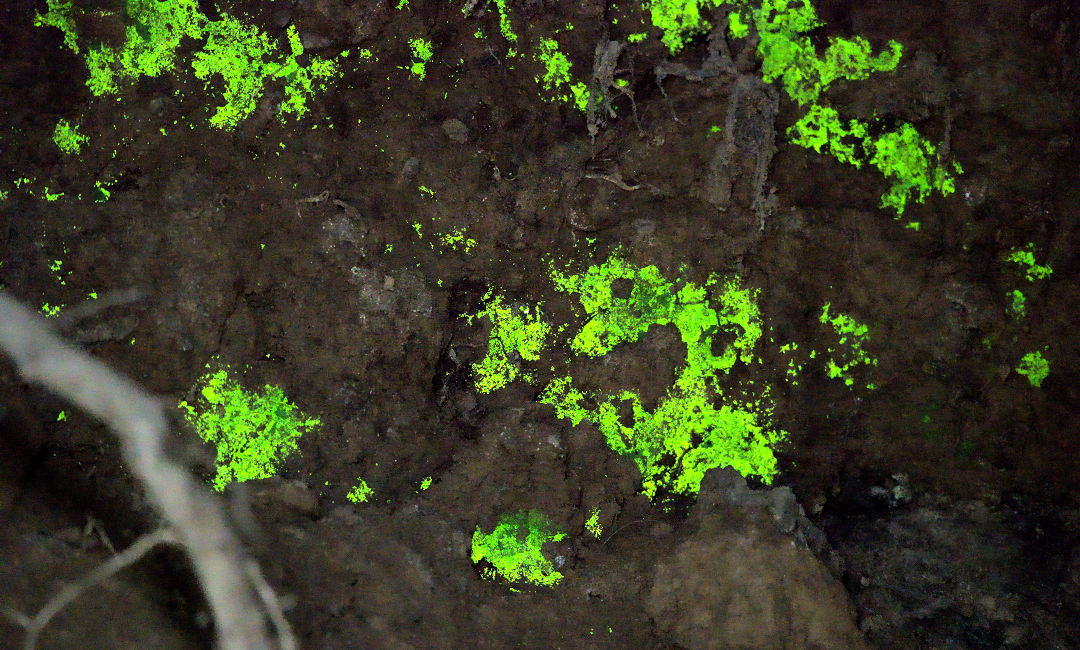A scientific team led by a researcher from the Estación Biológica de Doñana - CSIC has compiled all data available for Schistostega pennata, so-called goblin's gold, and created species distribution models in the Iberian Peninsula
This unique plant is distributed in only a few areas of the Iberian Peninsula, especially in the north and northwest, and its ecology is still poorly known. Many of its populations are threatened by human activity.
Schistostega pennata, commonly called ‘luminous moss' or ‘goblin's gold' is an unique species. It grows in shady areas, mainly at the entrance to caves, mines or natural and artificial hollows. It is recognisable because it reflects the little light it receives, creating a shimmering green glow. Despite its singularity, little is known about its ecology. To learn more about this species, a scientific team led by the Estación Biológica de Doñana - CSIC has compiled all the available information about it, modelled its distribution in the Iberian Peninsula and outlined certain aspects of its future conservation. Like many other species, it is in decline and could be disappearing.
Initially, the researchers located 26 new populations of Schistostega pennata on the Iberian Peninsula thanks to the records provided by several biodiversity observation platforms and their own observations, making a total of 73 identified so far on the Peninsula. Most of them are found in areas with abundant rainfall, mild temperatures and oceanic influence, and always in shady areas. In addition, the team has created a distribution model to find out which areas could be suitable for this luminescent moss to proliferate. According to the results, although its distribution would be concentrated in the coastal area of the north and northwest of the Iberian Peninsula, some Mediterranean areas in the centre-south and northeast of the Peninsula could also be suitable for this species, depending on whether they adjust to the specific climatic conditions it needs to develop. This is the first approximation to its potential distribution, not only for the Iberian but for the whole world, so these results are essential for carrying out surveys to learn more about the species and locate future populations.
By examining these populations, the scientific team also observed that this species could be facing conservation problems. In fact, one of the populations located in Beade (Vigo) is at risk of disappearing due to the construction of a road planned in a new urban development plan. "We have found that many of their populations are threatened by anthropization and some of them could soon disappear," says researcher Jairo Robla, first author of the study. "They face constant trampling, the threat of infrastructures constructions, vandalism, water extraction... Their habitat is so specific that any slight disturbance can seriously affect them. Given that it is a rare species in our territory, knowing where it is and where we could find new populations is very important to continue studying it in the future".
In addition to these human impacts, climate change, together with rising temperatures and low rainfall, is also affecting this species. It is believed that the populations of this luminescent moss could be declining and it is already considered as "vulnerable" such in the Spanish Red Book of Bryophytes, although it currently lacks effective legal protection. "This species makes us realise the need to study and get to know the biodiversity that we found in our surroundings, which is surprising indeed, but which we usually overlook", says the researcher. "Of course, we will continue to fight for legal protection in accordance with its vulnerable status and its biological and ecological singularity."
The location of the new populations of Schistostega pennata would have been impossible without the selfless contribution of many people who uploaded their observations to platforms such as Observation.org, iNaturalist or Global Biodiversiy Information Facility (GBIF). The researchers encourage anyone who sees this species to upload their observations to these citizen science platforms and to contact them to continue gathering information on this species in the future. "Only by getting to know where this unique species really is will we be able to draw up better conservation plans for the future. All help is welcome," concludes researcher Jairo Robla.









 Open Call for Research Projects in ICTS-Doñana!
Open Call for Research Projects in ICTS-Doñana!


